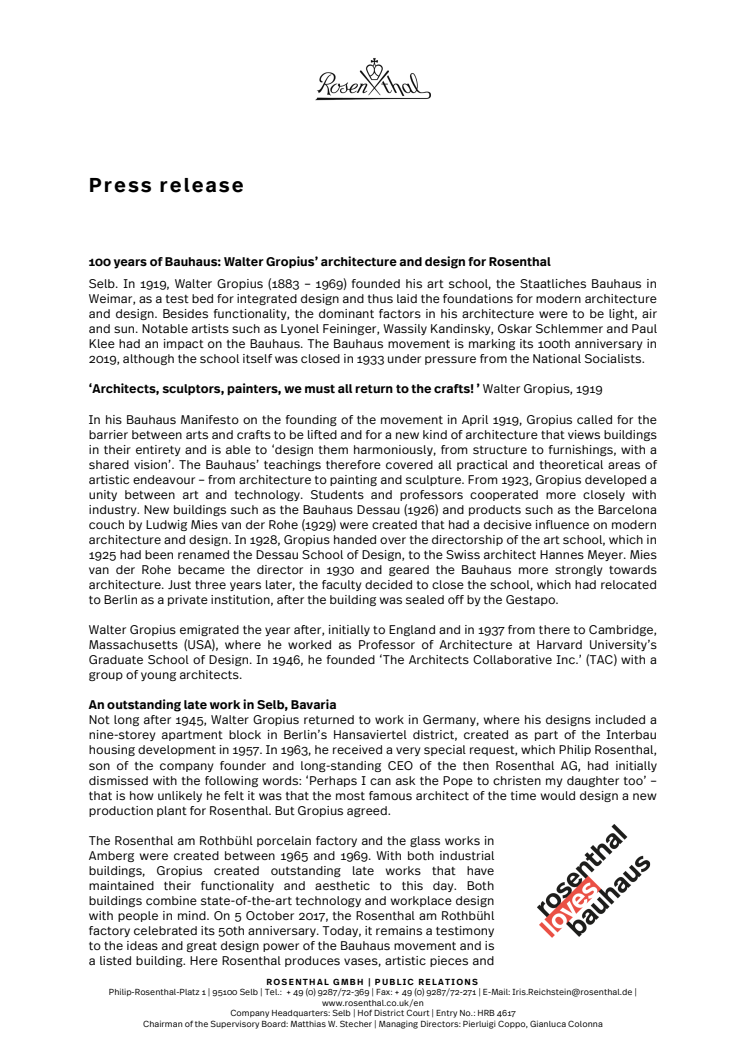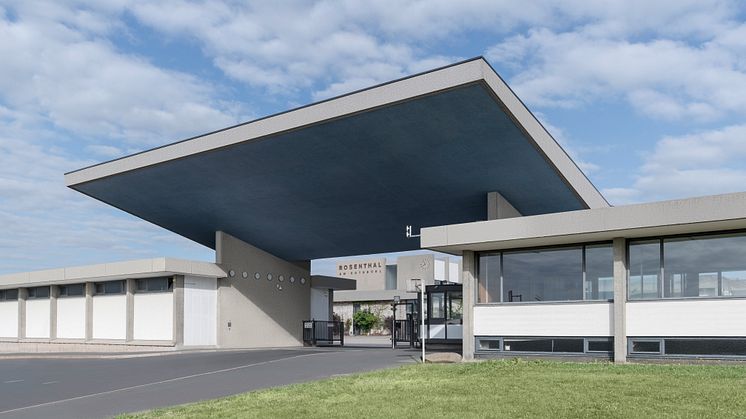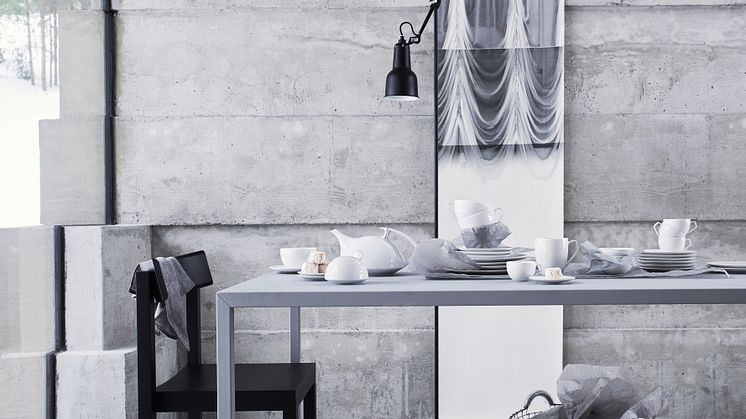Press release -
Happy Birthday Bauhaus: Rosenthal celebrates the centenary of the influential design school
100 years of Bauhaus: Walter Gropius’ architecture and design for Rosenthal
Selb. In 1919, Walter Gropius (1883 – 1969) founded his art school, the Staatliches Bauhaus in Weimar, as a test bed for integrated design and thus laid the foundations for modern architecture and design. Besides functionality, the dominant factors in his architecture were to be light, air and sun. Notable artists such as Lyonel Feininger, Wassily Kandinsky, Oskar Schlemmer and Paul Klee had an impact on the Bauhaus. The Bauhaus movement is marking its 100th anniversary in 2019, although the school itself was closed in 1933 under pressure from the National Socialists.
‘Architects, sculptors, painters, we must all return to the crafts! ’ Walter Gropius, 1919
In his Bauhaus Manifesto on the founding of the movement in April 1919, Gropius called for the barrier between arts and crafts to be lifted and for a new kind of architecture that views buildings in their entirety and is able to ‘design them harmoniously, from structure to furnishings, with a shared vision’. The Bauhaus’ teachings therefore covered all practical and theoretical areas of artistic endeavour – from architecture to painting and sculpture. From 1923, Gropius developed a unity between art and technology. Students and professors cooperated more closely with industry. New buildings such as the Bauhaus Dessau (1926) and products such as the Barcelona couch by Ludwig Mies van der Rohe (1929) were created that had a decisive influence on modern architecture and design. In 1928, Gropius handed over the directorship of the art school, which in 1925 had been renamed the Dessau School of Design, to the Swiss architect Hannes Meyer. Mies van der Rohe became the director in 1930 and geared the Bauhaus more strongly towards architecture. Just three years later, the faculty decided to close the school, which had relocated to Berlin as a private institution, after the building was sealed off by the Gestapo.
Walter Gropius emigrated the year after, initially to England and in 1937 from there to Cambridge, Massachusetts (USA), where he worked as Professor of Architecture at Harvard University’s Graduate School of Design. In 1946, he founded ‘The Architects Collaborative Inc.’ (TAC) with a group of young architects.
An outstanding late work in Selb, Bavaria

Not long after 1945, Walter Gropius returned to work in Germany, where his designs included a nine-storey apartment block in Berlin’s Hansaviertel district, created as part of the Interbau housing development in 1957. In 1963, he received a very special request, which Philip Rosenthal, son of the company founder and long-standing CEO of the then Rosenthal AG, had initially dismissed with the following words: ‘Perhaps I can ask the Pope to christen my daughter too’ – that is how unlikely he felt it was that the most famous architect of the time would design a new production plant for Rosenthal. But Gropius agreed.
The Rosenthal am Rothbühl porcelain factory and the glass works in Amberg were created between 1965 and 1969. With both industrial buildings, Gropius created outstanding late works that have maintained their functionality and aesthetic to this day. Both buildings combine state-of-the-art technology and workplace design with people in mind. On 5 October 2017, the Rosenthal am Rothbühl factory celebrated its 50th anniversary. Today, it remains a testimony to the ideas and great design power of the Bauhaus movement and is a listed building. Here Rosenthal produces vases, artistic pieces and teapots, also from real black porcelain with the greatest accuracy and craftsmanship.
Rosenthal am Rothbühl porcelain factory
In building the factory, Gropius and Rosenthal not only attached great importance to the technical modernity and architectural aesthetic, but also looked for opportunities to design the working environment positively. Philip Rosenthal (1916 – 2001) was concerned with the ‘designed environment’ featuring original art and design not only in living spaces, but also in cityscapes. ‘To me it was clear that a factory – or a business, a Rosenthal Studio shop – could be not a blight but an adornment on the cityscape and landscape. ’ When observed from a distance, the porcelain factory lies flat and, due to a strictly composed arrangement, like a sculpture on the landscape. The individual components of the area appear to be geometric elements that stand together rather than next to each other. The mighty winged roof, which is an almost magical sign to the entrance of the Rothbühl factory, makes a striking interruption in the ensemble. High window elements create generous visual contact with the outdoors and low-key coloured areas consistently break up the frequent monotony of the large hall structures. The glass wall ‘greenhouse’ is located in the centre of the production facility, providing a quiet green island for relaxing views. Gropius was sensitive to the human and social aspects of a building. In the old factory, employees adorned the windowsills with potted plants. This didn’t happen in the new factory. Gropius heard about the custom and then thought: ‘If individual flower pots can’t be displayed for technical and spatial reasons, then we’ll build a large flower pot for everyone. ’ The workforce was very happy with the greenhouse and its flamingos.
The factory itself is an elongated low-rise building that is accentuated in the centre by a protruding hall-like wing. This hall is suspended in externally visible U-shaped concrete girders, which demonstrate the construction principle of the entire building. The vertical division of the entire structure through the concrete pillars that were typical for Gropius (known as ‘hammerhead supports’) follows a module that corrects the horizontal emphasis of the elongated building as an optical-aesthetic principle.
Despite all of the necessary soberness of the industrial facility, the technically strong structure was nevertheless designed with care and detail. The ground beams were furnished with rough structures – inspired by Tapio Wirkkala’s ‘Variation’ tableware format – and given muted colours in sections to create a vivid, airy impression. The most significant and greatest architect remained a normal person. After losing a bet with Philip Rosenthal, Walter Gropius designed a pigsty for the Rosenthal am Rothbühl factory but it was never actually built.
In Selb, Gropius put his idea of ‘total architecture’, proposed decades ago, into practice – no molecule detached from the others, and no aesthetic that basks in the brilliance of its self-interest but instead is always subordinate to its purpose and integrated into the whole.
Rosenthal am Rothbühl:
Architect: Prof. Walter Gropius, Alex Cvijanovic (The Architects Collaborative Inc.)
Start of construction: April 1965
Opening: 5th October 1967
Building area: 21,000 square metres
Award: Silver plaque from the Federal Ministry for Regional Planning, Building and
Urban Planning in the ‘Industry in the Landscape’ competition (1975)
Amberg glass works
The ‘Glass Cathedral’ was opened in June 1970. It was the final work that Gropius designed, and he did not live to see it open. This design is another perfect demonstration of the high art of Bauhaus architecture. The glass works’ central ‘cathedral building’ was designed to ensure the fastest possible and unobstructed dissipation of heat. A sophisticated ventilation system in the roof ridge created an astonishingly pleasant environment to work in. The ribbon windows all around the building and the gable frontages entirely of glass gave off an impression of elegance and brightness. Here, too – like at the Rosenthal am Rothbühl factory – it was concrete walls and construction elements that initially defined the building. The second fundamental component was glass, which Gropius used to ensure that the outside world was always in view. A special feature was that the industrial building was deliberately ‘integrated into the landscape’ in a depression in the terrain, with only the roof and the nave of the production hall rising up from the grass as visible structures.
‘TAC 01’ tea service
During the planning and construction phase of the Rosenthal am Rothbühl factory, Walter Gropius became extremely interested in Rosenthal’s products. His enthusiasm for porcelain and his friendship with Philip Rosenthal culminated in him designing a service. ‘TAC 01’, a timeless, multi-award-winning fine-porcelain tea service named after Gropius’ Boston office ‘The Architects’ Collaborative’ (TAC), was created for Rosenthal in 1969. The idea of the half-sphere was put in practice and a variety of innovations were realised, including the bayonet mount with only one locking device for the lid of the pot. For the decoration, the designer called for an unbroken design and simple, ‘efficient’ curves. He put forward several variations from white matt or gloss glaze to small patterns of dots, lines, crosses or circles through to white with dark grey circular areas and the completely black ‘porcelain noire’. Since 1969, ‘TAC 01’ has been a successful part of the collection and one of the most important design classics at Rosenthal.
Related links
Topics
Categories
Rosenthal may have one of the longest traditions of Germany‘s companies, but is also one of the most modern. Just as we did when we were originally founded 140 years ago, Rosenthal develops products equally for discerning end customers and for exacting professional clients from the restaurant and hotel trade. Our products stand out with exceptional form, function, quality and craftsmanship and represent a cultural asset “made in Germany”, never ceasing to combine innovation and creativity. With its award-winning porcelain design, trendy lifestyle collections and modern, elegant classics, the Rosenthal brand raises the bar time and again for aesthetics and individuality.
Established figures from the worlds of architecture, design and art, but also the hottest newcomers and talents design avant-garde dinner table collections, foster a joy of giving and create sophisticated furnishings. The collections are manufactured in the Rosenthal porcelain factory in Selb and the “Thomas am Kulm” porcelain factory in Speichersdorf, which offer some of the porcelain industry‘s most advanced production facilities anywhere in the world and deliver sustainable manufacturing with careful use of resources thanks to the forward- looking investments that have been made.
New interior collections and accessories enrich the Rosenthal world by adding designer objects that go far beyond the limits of a conventional table setting and round off the huge product variety.




